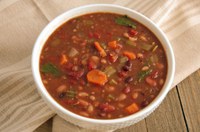Prairie Fare: Try Some Beautiful Beans
(Click an image below to view a high-resolution image that can be downloaded)
By Julie Garden-Robinson, Food and Nutrition Specialist
NDSU Extension
“Can you say ‘muy bellissimo’?” the participant said after taking a bite of the soup.
I did my best to pronounce it exactly as he did. However, I wasn’t getting the accent quite right. By the third try, I was kind of close, I think. He grinned, anyway.
Maybe he gave up on my pronunciation skills.
I knew what he meant. He thought the soup was very good.
Actually, he said the soup was “very beautiful.”
His wife smiled at me. Maybe they will make the recipe back home.
Besides the soup, my guests also tried black bean brownies. What’s not to like about chocolate with an added fiber boost from beans?
I was doing a presentation about beans for international visitors from South America, North America, Asia and Europe. The visitors had various positions in their countries, but many were involved with procurement of agricultural commodities for their countries. Others were involved in food manufacturing.
As I’ve learned, giving people an opportunity to taste is a good way to get them to appreciate food. Grocery stores are well acquainted with the power of small samples of food.
I provided a presentation about the nutritional value and potential health benefits of beans. Beans, such as pinto, kidney and navy beans, are excellent sources of protein and fiber.
Eating more fiber-rich foods, such as beans, may reduce our risk for heart disease, cancer, diabetes and other diseases.
We in the U.S. tend to like food preparation to be fast and fairly easy. Beans typically require soaking and cooking, so sometimes people shy away from using beans from their dry state.
We prepared the soup in a multifunction pressure cooker. Most of my attendees were not familiar with the wildly popular multifunction cookers, such as the Instant Pot. The bean soup recipe was done in about 40 minutes in a pressure cooker.
Multifunction cookers allow you to brown meat, pressure cook, slow cook and, perhaps, make yogurt or a range of desserts.
Many brands of multifunction cookers are available. However, be sure to review the manufacturer’s instructions that accompanied your multicooker because brands vary in their functions.
During the past several months, we tested several recipes in three different multicookers; in some cases, we soaked the beans and in other cases, including the recipe provided with this column, we placed all the ingredients in the cooker.
Here are some basic steps in preparing beans in a pressure cooker. Keep in mind that beans may froth or foam during cooking, so fill the pressure cooker no more than half full.
Most pressure cookers also need a minimum amount of liquid to operate correctly, so check your directions. You also may want to add some oil and salt to the cooking water to help beans retain their shape as well as foam less.
- Sort 1 pound (2 cups) of dry beans to remove any split beans or small stones that may be in the bag. Rinse.
- Drain beans and rinse thoroughly. Place beans in a pressure cooker and cover with about 4 cups of fresh water. Water should be about 2 inches above the beans. Optionally, add 1 teaspoon or to taste of salt if you want extra flavor in your beans.
- Seal the pressure cooker according to the manufacturer’s instructions. Press “manual” and set to “high pressure.” Adjust times as needed. Cooking longer will yield softer beans.
- Allow 20 minutes for natural pressure release after cooking. If beans are not quite tender, cook them again on high pressure for 10 minutes and then quick release the pressure. Drain immediately.
These are the approximate pressure cooking times for various types of beans:
- Black beans: 20 to 30 minutes
- Pinto beans: 15 to 20 minutes
- Navy beans: 25 to 35 minutes
- Kidney beans: 20 to 30 minutes
- Garbanzo beans: 15 to 25 minutes
Here’s the recipe proclaimed “muy bellissimo.” See https://tinyurl.com/DryEdibleBeans-NDSU to check out the wide range of bean resources from NDSU Extension.
7-Bean Vegetarian Soup (Pressure Cooker)
1/2 c. navy beans, dry
1/2 c. black beans, dry
1/4 c. pinto beans, dry
1/4 c. kidney beans, dry
1/4 c. black-eyed peas, dry
1/4 c. red lentils, dry
1/4 c. green lentils, dry
1 Tbsp. olive oil
4 carrots, chopped
4 celery stalks, chopped
1 large onion, chopped (about 1 1/2 c., chopped)
1 Tbsp. garlic, minced
8 c. low-sodium vegetable broth
1 tsp. salt
1/2 tsp. black pepper
1/2 Tbsp. thyme, dry
1/2 tsp. sage, dry
1 (14-oz.) can diced tomatoes
2 bay leaves
1 c. kale, chopped
Turn the pressure cooker to saute function. Add oil and heat until the oil shimmers. Rinse then prepare vegetables as directed. Saute carrots, celery, onion and garlic until softened and translucent. Add remaining ingredients except kale and cover with the lid seal to lock. Press the manual pressure cook button and set the timer to 20 minutes. Let the pressure release naturally for 10 to 15 minutes. Release any remaining pressure and remove cover. Add kale and cook for five more minutes. Then remove the bay leaves and serve.
Makes 11 (1-cup) servings. Each serving has 170 calories, 2 grams (g) fat, 9 g protein, 30 g carbohydrate, 7 g fiber and 360 milligrams sodium.
(Julie Garden-Robinson, Ph.D., R.D., L.R.D., is a North Dakota State University Extension food and nutrition specialist and professor in the Department of Health, Nutrition and Exercise Sciences. Follow her on Twitter @jgardenrobinson)
NDSU Agriculture Communication - Sept. 26, 2019
| Source: | Julie Garden-Robinson, 701-231-7187, julie.garden-robinson@ndsu.edu |
|---|---|
| Editor: | Ellen Crawford, 701-231-5391, ellen.crawford@ndsu.edu |



